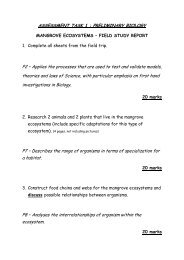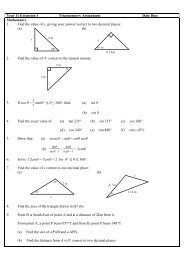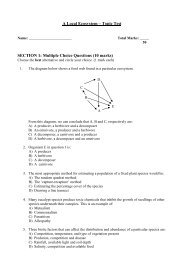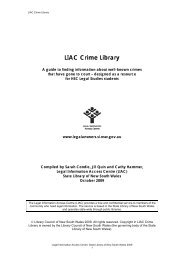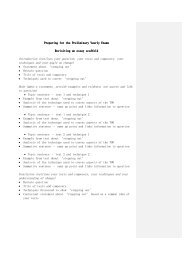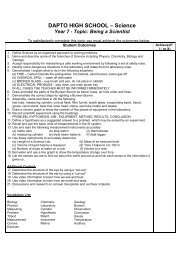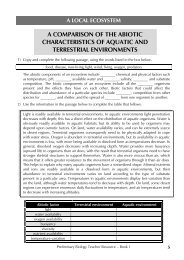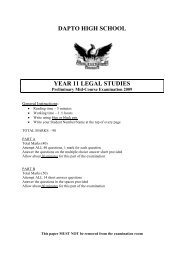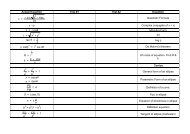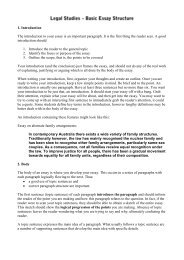Preliminary Society and Culture Assessment Task Personal and ...
Preliminary Society and Culture Assessment Task Personal and ...
Preliminary Society and Culture Assessment Task Personal and ...
You also want an ePaper? Increase the reach of your titles
YUMPU automatically turns print PDFs into web optimized ePapers that Google loves.
Outcomes assessed<br />
The student:<br />
P3<br />
P6<br />
P7<br />
P8<br />
P9<br />
P10<br />
P11<br />
<strong>Preliminary</strong> <strong>Society</strong> <strong>and</strong> <strong>Culture</strong><br />
<strong>Assessment</strong> <strong>Task</strong> <strong>Personal</strong> <strong>and</strong> Social <strong>and</strong> Identity<br />
‘Underst<strong>and</strong>ing Adolescence’<br />
describes cultural diversity <strong>and</strong> commonality within societies <strong>and</strong> cultures<br />
differentiates between, <strong>and</strong> applies, the methodologies of social <strong>and</strong> cultural<br />
research<br />
applies appropriate language <strong>and</strong> concepts associated with society <strong>and</strong> culture<br />
selects, organises <strong>and</strong> considers information <strong>and</strong> sources for usefulness, validity<br />
<strong>and</strong> bias<br />
plans an investigation <strong>and</strong> analyses information from a variety of perspectives<br />
<strong>and</strong> sources<br />
communicates information, ideas <strong>and</strong> issues using appropriate written, oral <strong>and</strong><br />
graphic forms<br />
works independently <strong>and</strong> in groups to achieve appropriate goals in set timelines<br />
The task<br />
Part 1 – 20 marks<br />
You are to use content analysis to compare the way television portrays adolescence<br />
<strong>and</strong> adolescent experiences in Australia <strong>and</strong> on other country.<br />
This will require you to set up a grid to analyse the TV shows you are watching. You<br />
should be able to make comments upon the presentation of various aspects of<br />
adolescent life, including things such as relationships with peers <strong>and</strong> parents, language,<br />
fashion, social values <strong>and</strong> beliefs.<br />
In doing this you should compare two different TV shows, one of which must be<br />
Australia. You should maintain a log of watching, <strong>and</strong> present an accurate record of<br />
what you watched <strong>and</strong> what your content analysis revealed.<br />
After completing your watching, log <strong>and</strong> analysis, you should present a report. This<br />
report should show areas of similarity <strong>and</strong> difference in the way the two TV shows<br />
portray adolescent experiences. You must apply statistical analysis to at least one<br />
aspect of your findings in presenting your final report. You should also include your<br />
viewing log as part of the report.
Part 2 – 10 marks<br />
Evaluate your research from Part 1, commenting upon the usefulness, validity <strong>and</strong> bias<br />
of your sources.<br />
Part 3 – 10 marks<br />
Using your research findings <strong>and</strong> any other appropriate material, answer the following<br />
question: ‘How is adolescence portrayed on television How does this portrayal<br />
compare to your own experience’<br />
______________________________________________________________________<br />
The task<br />
Part 1<br />
□ Have you set up a grid<br />
□ Have you made comments on the grid<br />
□ Is one of the shows Australian<br />
□ Can you present a viewing log<br />
□ Can you show what your content analysis revealed<br />
□ Have you presented a report<br />
□ Have you shown areas of similarity <strong>and</strong> difference in the way the two TV shows<br />
portray adolescent experiences<br />
□ Have you applied statistical analysis in your final report<br />
□ Have you included your viewing log as part of the report<br />
Part 2<br />
□ Have you evaluated your research from Part 1<br />
□ Have you commented upon usefulness, validity <strong>and</strong> bias<br />
Part 3<br />
□ Have you used your research findings<br />
□ Have you used any other appropriate material<br />
□ Have you compared to your own experience<br />
□ Have you included an annotated bibliography
Marking criteria<br />
Criteria<br />
• Displays a high level of underst<strong>and</strong>ing of the way television depicts<br />
the adolescent experience in Australia <strong>and</strong> one other country<br />
through the use of a range of specific examples<br />
• Presents clearly the findings of specific research in appropriate<br />
form<br />
• Communicates clearly <strong>and</strong> directly an underst<strong>and</strong>ing of the nature<br />
<strong>and</strong> implication of media presentation of adolescence <strong>and</strong><br />
adolescent issues<br />
• Displays an underst<strong>and</strong>ing of the nature <strong>and</strong> application of<br />
statistical analysis<br />
• Communicates an underst<strong>and</strong>ing of their own experience of<br />
adolescent <strong>and</strong> compare that with media representations using<br />
appropriate language <strong>and</strong> concepts<br />
• Utilises a range of relevant resources, <strong>and</strong> displays an<br />
underst<strong>and</strong>ing of their validity <strong>and</strong> use<br />
• Produces a clearly annotated bibliography<br />
• Displays an underst<strong>and</strong>ing of the way television depicts the<br />
adolescent experience in Australia <strong>and</strong> one other country through<br />
the use of a range of specific examples<br />
• Presents the findings of specific research in appropriate form<br />
• Communicates an underst<strong>and</strong>ing of the nature <strong>and</strong> implication of<br />
media presentation of adolescence <strong>and</strong> adolescent issues<br />
• Applies statistical analysis<br />
• Communicates an underst<strong>and</strong>ing of their own experience of<br />
adolescent <strong>and</strong> compare that with media representations using<br />
some appropriate language <strong>and</strong> concepts<br />
• Utilises a range of relevant resources, <strong>and</strong> displays some<br />
underst<strong>and</strong>ing of their validity <strong>and</strong> use<br />
• Produces an annotated bibliography<br />
• Displays limited underst<strong>and</strong>ing of the way television depicts the<br />
adolescent experience in Australia <strong>and</strong> one other country through<br />
the use of a range of specific examples<br />
• Presents specific research in appropriate form<br />
• Communicates some underst<strong>and</strong>ing of the nature <strong>and</strong> implication<br />
of media presentation of adolescence <strong>and</strong> adolescent issues<br />
• Applies statistical analysis in a limited form<br />
• Describes own experience of adolescent <strong>and</strong> compare that with<br />
limited use of appropriate language <strong>and</strong> concepts<br />
• Utilises resources, <strong>and</strong> displays some underst<strong>and</strong>ing of their<br />
validity <strong>and</strong> use<br />
• Produces an annotated bibliography<br />
Mark<br />
31- 40<br />
21 - 30<br />
11 - 20
• Describes television depiction of the adolescent experience in<br />
Australia <strong>and</strong> one other country with limited examples<br />
• Presents some findings of specific research<br />
• Describes some media representation of adolescence <strong>and</strong><br />
adolescent issues<br />
• Produces basic statistic analysis<br />
• Describes own experience of adolescence <strong>and</strong> that of others with<br />
few examples of appropriate language or concepts<br />
• Uses a limited range of resources, with limited underst<strong>and</strong>ing of<br />
their validty <strong>and</strong> use<br />
• Produces a bibliography<br />
0 – 10 marks




